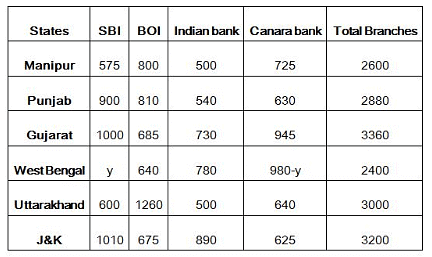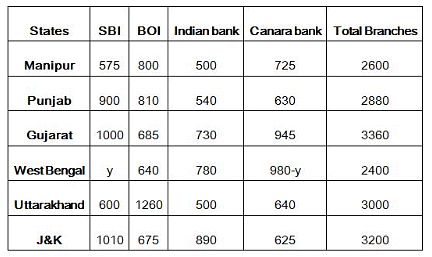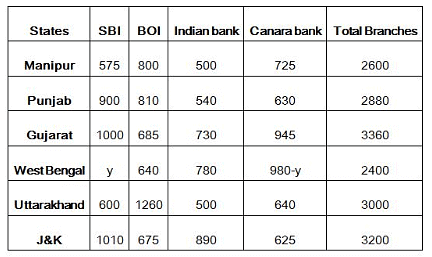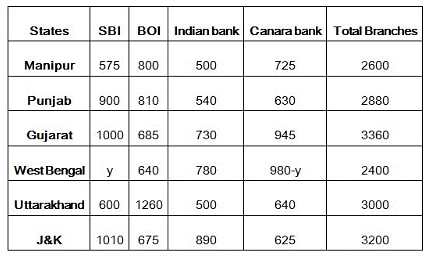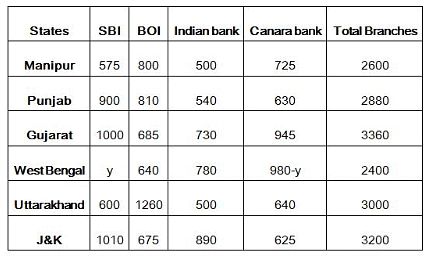PFRDA Assistant Manager Phase 1 Mock Test - 10 (Paper 1) - Insurance Exams MCQ
30 Questions MCQ Test - PFRDA Assistant Manager Phase 1 Mock Test - 10 (Paper 1)
Direction: Read the following passage carefully and answer the question that follow.
The Supreme Court on Tuesday asked the Union government whether it is giving the over 40 lakh people, excluded from the National Register of Citizens (NRC) in Assam, a “second chance” to gain citizenship by allowing them to produce fresh documents to prove their Indian legacy.
The court was referring to the Standard Operating Procedure (SOP) proposed by the government, which allows a claimant for Indian citizenship to “change his legacy” by submitting additional documents at the ‘claims and objections’ stage. The court asked whether this would amount to “re-doing the claims” of those left out from the draft NRC published on July 30.
A Bench of Justices Ranjan Gogoi and Rohinton Nariman on Tuesday said allowing a claimant to change his legacy would amount to “tinkering with the family tree” and re-doing the verification process.
“You see, a claimant submits documents to prove his legacy from his father. A family tree is drawn, which includes the claimant’s siblings, etc. The authorities verify his claim with each one of the member in the family tree before deciding his claim [for citizenship]. Now, your SOP says that a person can submit fresh documents claiming to prove his legacy from his grandfather. Now, the family tree has to be recreated. Everything has to be re-verified. This amounts to redoing the entire exercise. Why?”, Justice Gogoi asked Attorney General K.K. Venugopal.
Besides, the Bench pointed out, the government, in the beginning, had specified that documents on legacy would be allowed to be filed only once. Now, it has changed tack to permit additional documents to be filed. “Are you not contradicting yourself here?” Justice Gogoi asked Mr. Venugopal.
The court directed Assam State NRC Coordinator Prateek Hajela to file a report on the ramifications of the government's proposal to submit fresh documents. Mr. Hajela has to file his report before September 5, the next date of hearing.
Meanwhile, the court deferred the receipt of claims and objections to a later date. This stage was supposed to start within the next days, on August 30, and would have continued till October 28.
“Allowing a person to suddenly pull out an additional document, that too at the 'claims and objections' stage, will upset the search apple cart,” Justice Nariman observed.
Mr. Venugopal countered that the government is giving “another chance to people who risk losing all their rights”.
To this, Justice Nariman agreed that the court was dealing with “human problems of a huge magnitude”.
“Consequences are so severe that should they be given one more chance. Suppose a claimant has misfired once but can deliver in the next. Why should such a person not be given another chance?” Justice Nariman asked Mr. Hajela, stakeholders and petitioners in the litigation.
To this, Mr. Hajela said reopening of family trees would risk the possibility of “trading of legacies or meeting of minds”. "Giving a second chance would only open trading in legacies. There may be people who are willing to sell the legacies to others,” he said.
The Supreme Court further asked Mr. Hajela to submit a report with a time-frame to carry out the sample re-verification of at least 10 per cent of the names included in the final draft NRC. This is after Mr. Hajela placed before the Bench a district-wise data of the percentage of the population who have been excluded from the final draft NRC.
Q. Why has the Supreme Court observed that the new move by the government will actually make the government redo the whole exercise?
Direction: Read the following passage carefully and answer the question that follows.
The Supreme Court on Tuesday asked the Union government whether it is giving the over 40 lakh people, excluded from the National Register of Citizens (NRC) in Assam, a “second chance” to gain citizenship by allowing them to produce fresh documents to prove their Indian legacy.
The court was referring to the Standard Operating Procedure (SOP) proposed by the government, which allows a claimant for Indian citizenship to “change his legacy” by submitting additional documents at the ‘claims and objections’ stage. The court asked whether this would amount to “re-doing the claims” of those left out from the draft NRC published on July 30.
A Bench of Justices Ranjan Gogoi and Rohinton Nariman on Tuesday said allowing a claimant to change his legacy would amount to “tinkering with the family tree” and re-doing the verification process.
“You see, a claimant submits documents to prove his legacy from his father. A family tree is drawn, which includes the claimant’s siblings, etc. The authorities verify his claim with each one of the member in the family tree before deciding his claim [for citizenship]. Now, your SOP says that a person can submit fresh documents claiming to prove his legacy from his grandfather. Now, the family tree has to be recreated. Everything has to be re-verified. This amounts to redoing the entire exercise. Why?”, Justice Gogoi asked Attorney General K.K. Venugopal.
Besides, the Bench pointed out, the government, in the beginning, had specified that documents on legacy would be allowed to be filed only once. Now, it has changed tack to permit additional documents to be filed. “Are you not contradicting yourself here?” Justice Gogoi asked Mr. Venugopal.
The court directed Assam State NRC Coordinator Prateek Hajela to file a report on the ramifications of the government's proposal to submit fresh documents. Mr. Hajela has to file his report before September 5, the next date of hearing.
Meanwhile, the court deferred the receipt of claims and objections to a later date. This stage was supposed to start within the next days, on August 30, and would have continued till October 28.
“Allowing a person to suddenly pull out an additional document, that too at the 'claims and objections' stage, will upset the search apple cart,” Justice Nariman observed.
Mr. Venugopal countered that the government is giving “another chance to people who risk losing all their rights”.
To this, Justice Nariman agreed that the court was dealing with “human problems of a huge magnitude”.
“Consequences are so severe that should they be given one more chance. Suppose a claimant has misfired once but can deliver in the next. Why should such a person not be given another chance?” Justice Nariman asked Mr. Hajela, stakeholders and petitioners in the litigation.
To this, Mr. Hajela said reopening of family trees would risk the possibility of “trading of legacies or meeting of minds”. "Giving a second chance would only open trading in legacies. There may be people who are willing to sell the legacies to others,” he said.
The Supreme Court further asked Mr. Hajela to submit a report with a time-frame to carry out the sample re-verification of at least 10 per cent of the names included in the final draft NRC. This is after Mr. Hajela placed before the Bench a district-wise data of the percentage of the population who have been excluded from the final draft NRC.
Q. Which among the following is a possible consequence of the new standard operating procedure adopted by the Government regarding the National Register of Citizens?
Direction: Read the following passage carefully and answer the question that follows.
The Supreme Court on Tuesday asked the Union government whether it is giving the over 40 lakh people, excluded from the National Register of Citizens (NRC) in Assam, a “second chance” to gain citizenship by allowing them to produce fresh documents to prove their Indian legacy.
The court was referring to the Standard Operating Procedure (SOP) proposed by the government, which allows a claimant for Indian citizenship to “change his legacy” by submitting additional documents at the ‘claims and objections’ stage. The court asked whether this would amount to “re-doing the claims” of those left out from the draft NRC published on July 30.
A Bench of Justices Ranjan Gogoi and Rohinton Nariman on Tuesday said allowing a claimant to change his legacy would amount to “tinkering with the family tree” and re-doing the verification process.
“You see, a claimant submits documents to prove his legacy from his father. A family tree is drawn, which includes the claimant’s siblings, etc. The authorities verify his claim with each one of the member in the family tree before deciding his claim [for citizenship]. Now, your SOP says that a person can submit fresh documents claiming to prove his legacy from his grandfather. Now, the family tree has to be recreated. Everything has to be re-verified. This amounts to redoing the entire exercise. Why?”, Justice Gogoi asked Attorney General K.K. Venugopal.
Besides, the Bench pointed out, the government, in the beginning, had specified that documents on legacy would be allowed to be filed only once. Now, it has changed tack to permit additional documents to be filed. “Are you not contradicting yourself here?” Justice Gogoi asked Mr. Venugopal.
The court directed Assam State NRC Coordinator Prateek Hajela to file a report on the ramifications of the government's proposal to submit fresh documents. Mr. Hajela has to file his report before September 5, the next date of hearing.
Meanwhile, the court deferred the receipt of claims and objections to a later date. This stage was supposed to start within the next days, on August 30, and would have continued till October 28.
“Allowing a person to suddenly pull out an additional document, that too at the 'claims and objections' stage, will upset the search apple cart,” Justice Nariman observed.
Mr. Venugopal countered that the government is giving “another chance to people who risk losing all their rights”.
To this, Justice Nariman agreed that the court was dealing with “human problems of a huge magnitude”.
“Consequences are so severe that should they be given one more chance. Suppose a claimant has misfired once but can deliver in the next. Why should such a person not be given another chance?” Justice Nariman asked Mr. Hajela, stakeholders and petitioners in the litigation.
To this, Mr. Hajela said reopening of family trees would risk the possibility of “trading of legacies or meeting of minds”. "Giving a second chance would only open trading in legacies. There may be people who are willing to sell the legacies to others,” he said.
The Supreme Court further asked Mr. Hajela to submit a report with a time-frame to carry out the sample re-verification of at least 10 per cent of the names included in the final draft NRC. This is after Mr. Hajela placed before the Bench a district-wise data of the percentage of the population who have been excluded from the final draft NRC.
Q. Which among the following substantiates the observation of the Supreme Court that the government is contradicting its own stand in the issue of National Register of Citizens?
Direction: Read the following passage carefully and answer the question that follows.
The Supreme Court on Tuesday asked the Union government whether it is giving the over 40 lakh people, excluded from the National Register of Citizens (NRC) in Assam, a “second chance” to gain citizenship by allowing them to produce fresh documents to prove their Indian legacy.
The court was referring to the Standard Operating Procedure (SOP) proposed by the government, which allows a claimant for Indian citizenship to “change his legacy” by submitting additional documents at the ‘claims and objections’ stage. The court asked whether this would amount to “re-doing the claims” of those left out from the draft NRC published on July 30.
A Bench of Justices Ranjan Gogoi and Rohinton Nariman on Tuesday said allowing a claimant to change his legacy would amount to “tinkering with the family tree” and re-doing the verification process.
“You see, a claimant submits documents to prove his legacy from his father. A family tree is drawn, which includes the claimant’s siblings, etc. The authorities verify his claim with each one of the member in the family tree before deciding his claim [for citizenship]. Now, your SOP says that a person can submit fresh documents claiming to prove his legacy from his grandfather. Now, the family tree has to be recreated. Everything has to be re-verified. This amounts to redoing the entire exercise. Why?”, Justice Gogoi asked Attorney General K.K. Venugopal.
Besides, the Bench pointed out, the government, in the beginning, had specified that documents on legacy would be allowed to be filed only once. Now, it has changed tack to permit additional documents to be filed. “Are you not contradicting yourself here?” Justice Gogoi asked Mr. Venugopal.
The court directed Assam State NRC Coordinator Prateek Hajela to file a report on the ramifications of the government's proposal to submit fresh documents. Mr. Hajela has to file his report before September 5, the next date of hearing.
Meanwhile, the court deferred the receipt of claims and objections to a later date. This stage was supposed to start within the next days, on August 30, and would have continued till October 28.
“Allowing a person to suddenly pull out an additional document, that too at the 'claims and objections' stage, will upset the search apple cart,” Justice Nariman observed.
Mr. Venugopal countered that the government is giving “another chance to people who risk losing all their rights”.
To this, Justice Nariman agreed that the court was dealing with “human problems of a huge magnitude”.
“Consequences are so severe that should they be given one more chance. Suppose a claimant has misfired once but can deliver in the next. Why should such a person not be given another chance?” Justice Nariman asked Mr. Hajela, stakeholders and petitioners in the litigation.
To this, Mr. Hajela said reopening of family trees would risk the possibility of “trading of legacies or meeting of minds”. "Giving a second chance would only open trading in legacies. There may be people who are willing to sell the legacies to others,” he said.
The Supreme Court further asked Mr. Hajela to submit a report with a time-frame to carry out the sample re-verification of at least 10 per cent of the names included in the final draft NRC. This is after Mr. Hajela placed before the Bench a district-wise data of the percentage of the population who have been excluded from the final draft NRC.
Q. Which among the following is true regarding the view of the Supreme Court regarding the Standard Operating Procedure announced by the government?
Direction: Read the following passage carefully and answer the question that follows.
The Supreme Court on Tuesday asked the Union government whether it is giving the over 40 lakh people, excluded from the National Register of Citizens (NRC) in Assam, a “second chance” to gain citizenship by allowing them to produce fresh documents to prove their Indian legacy.
The court was referring to the Standard Operating Procedure (SOP) proposed by the government, which allows a claimant for Indian citizenship to “change his legacy” by submitting additional documents at the ‘claims and objections’ stage. The court asked whether this would amount to “re-doing the claims” of those left out from the draft NRC published on July 30.
A Bench of Justices Ranjan Gogoi and Rohinton Nariman on Tuesday said allowing a claimant to change his legacy would amount to “tinkering with the family tree” and re-doing the verification process.
“You see, a claimant submits documents to prove his legacy from his father. A family tree is drawn, which includes the claimant’s siblings, etc. The authorities verify his claim with each one of the member in the family tree before deciding his claim [for citizenship]. Now, your SOP says that a person can submit fresh documents claiming to prove his legacy from his grandfather. Now, the family tree has to be recreated. Everything has to be re-verified. This amounts to redoing the entire exercise. Why?”, Justice Gogoi asked Attorney General K.K. Venugopal.
Besides, the Bench pointed out, the government, in the beginning, had specified that documents on legacy would be allowed to be filed only once. Now, it has changed tack to permit additional documents to be filed. “Are you not contradicting yourself here?” Justice Gogoi asked Mr. Venugopal.
The court directed Assam State NRC Coordinator Prateek Hajela to file a report on the ramifications of the government's proposal to submit fresh documents. Mr. Hajela has to file his report before September 5, the next date of hearing.
Meanwhile, the court deferred the receipt of claims and objections to a later date. This stage was supposed to start within the next days, on August 30, and would have continued till October 28.
“Allowing a person to suddenly pull out an additional document, that too at the 'claims and objections' stage, will upset the search apple cart,” Justice Nariman observed.
Mr. Venugopal countered that the government is giving “another chance to people who risk losing all their rights”.
To this, Justice Nariman agreed that the court was dealing with “human problems of a huge magnitude”.
“Consequences are so severe that should they be given one more chance. Suppose a claimant has misfired once but can deliver in the next. Why should such a person not be given another chance?” Justice Nariman asked Mr. Hajela, stakeholders and petitioners in the litigation.
To this, Mr. Hajela said reopening of family trees would risk the possibility of “trading of legacies or meeting of minds”. "Giving a second chance would only open trading in legacies. There may be people who are willing to sell the legacies to others,” he said.
The Supreme Court further asked Mr. Hajela to submit a report with a time-frame to carry out the sample re-verification of at least 10 per cent of the names included in the final draft NRC. This is after Mr. Hajela placed before the Bench a district-wise data of the percentage of the population who have been excluded from the final draft NRC.
Q. Which among the following is true regarding the new move of the Government regarding the National Register of Citizens in Assam?
Direction: In each of the questions given below, a paragraph is given which has some blanks and those blanks have to be filled with the same word out of five words given below it. You have to choose that same word as your answer and fill up the blanks with that appropriate word.
The ____________ between both the parties was signed by the representatives from the two leading firms. Most of the board members were in ____________ with the proposal to merge the two companies for the purpose of survival. This ____________ will pave the way for further development of the sector in the country.
Direction: In the questions given below a sentence is given with two blanks in each. Corresponding to each question two columns are given with three words in each column. Which combination of words from the two columns will perfectly fit into the blanks to make the sentence contextually correct and meaningful?
The protests in Guwahati were the most intense so far and some of the infrastructure being built for the ____________ between PM Abe and PM Modi were ____________ and burnt by the protesters.
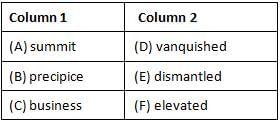
Direction: Each question below has one blank, which is indicating that something has been omitted. Find out which option can be used to fill up the blank in the sentence in the same sequence to make it meaningfully complete.
The tax department has been stepping up its _____________ of your financial activities and it has also been making compliance easy.
Directions: In the following passage, some of the words have been left out, each of which is indicated by a letter. Find the suitable word from the options given against each letter and fill up the blanks with appropriate words to make the paragraph meaningful.
The chess world was _____(A)_____ in late 2022 when Magnus Carlsen, the current world champion, accused Hans Niemann, a 19-year-old US chess grandmaster, of cheating using a chess-playing artificial intelligence (AI) system. Niemann had defeated Carlsen, prompting Carlsen’s _____(B)_____; Niemann asserted that he had played Carlsen fairly even though he later admitted to having cheated twice in online chess games, at the ages of 12 and 16.
A month later, a 72-page investigation report drafted by Chess.com _____(C)_____ that Niemann had “likely cheated” more than a hundred times while playing online chess. But the report also said, “There is no direct _____(D)_____ that proves Hans cheated at the September 4, 2022, game with Magnus.”
Cheating in chess has become a major problem, especially in the online era. Among the more-than 500,000 accounts that Chess.com has _____(E)_____ for cheating, more than 500 belonged to titled players (titling is a mark of skill). By the beginning of 2024, the site expects to close more than a million accounts.
Q. Select the most appropriate option that will fill in the blank (A).
Directions: In the following passage, some of the words have been left out, each of which is indicated by a letter. Find the suitable word from the options given against each letter and fill up the blanks with appropriate words to make the paragraph meaningful.
The chess world was _____(A)_____ in late 2022 when Magnus Carlsen, the current world champion, accused Hans Niemann, a 19-year-old US chess grandmaster, of cheating using a chess-playing artificial intelligence (AI) system. Niemann had defeated Carlsen, prompting Carlsen’s _____(B)_____; Niemann asserted that he had played Carlsen fairly even though he later admitted to having cheated twice in online chess games, at the ages of 12 and 16.
A month later, a 72-page investigation report drafted by Chess.com _____(C)_____ that Niemann had “likely cheated” more than a hundred times while playing online chess. But the report also said, “There is no direct _____(D)_____ that proves Hans cheated at the September 4, 2022, game with Magnus.”
Cheating in chess has become a major problem, especially in the online era. Among the more-than 500,000 accounts that Chess.com has _____(E)_____ for cheating, more than 500 belonged to titled players (titling is a mark of skill). By the beginning of 2024, the site expects to close more than a million accounts.
Q. Select the most appropriate option that will fill in the blank (C).
Directions: In the following passage, some of the words have been left out, each of which is indicated by a letter. Find the suitable word from the options given against each letter and fill up the blanks with appropriate words to make the paragraph meaningful.
The chess world was _____(A)_____ in late 2022 when Magnus Carlsen, the current world champion, accused Hans Niemann, a 19-year-old US chess grandmaster, of cheating using a chess-playing artificial intelligence (AI) system. Niemann had defeated Carlsen, prompting Carlsen’s _____(B)_____; Niemann asserted that he had played Carlsen fairly even though he later admitted to having cheated twice in online chess games, at the ages of 12 and 16.
A month later, a 72-page investigation report drafted by Chess.com _____(C)_____ that Niemann had “likely cheated” more than a hundred times while playing online chess. But the report also said, “There is no direct _____(D)_____ that proves Hans cheated at the September 4, 2022, game with Magnus.”
Cheating in chess has become a major problem, especially in the online era. Among the more-than 500,000 accounts that Chess.com has _____(E)_____ for cheating, more than 500 belonged to titled players (titling is a mark of skill). By the beginning of 2024, the site expects to close more than a million accounts.
Q. Select the most appropriate option that will fill in the blank (E).
Directions: In the following passage, some of the words have been left out, each of which is indicated by a letter. Find the suitable word from the options given against each letter and fill up the blanks with appropriate words to make the paragraph meaningful.
The chess world was _____(A)_____ in late 2022 when Magnus Carlsen, the current world champion, accused Hans Niemann, a 19-year-old US chess grandmaster, of cheating using a chess-playing artificial intelligence (AI) system. Niemann had defeated Carlsen, prompting Carlsen’s _____(B)_____; Niemann asserted that he had played Carlsen fairly even though he later admitted to having cheated twice in online chess games, at the ages of 12 and 16.
A month later, a 72-page investigation report drafted by Chess.com _____(C)_____ that Niemann had “likely cheated” more than a hundred times while playing online chess. But the report also said, “There is no direct _____(D)_____ that proves Hans cheated at the September 4, 2022, game with Magnus.”
Cheating in chess has become a major problem, especially in the online era. Among the more-than 500,000 accounts that Chess.com has _____(E)_____ for cheating, more than 500 belonged to titled players (titling is a mark of skill). By the beginning of 2024, the site expects to close more than a million accounts.
Q. Select the most appropriate option that will fill in the blank (B).
Directions: In the following passage, some of the words have been left out, each of which is indicated by a letter. Find the suitable word from the options given against each letter and fill up the blanks with appropriate words to make the paragraph meaningful.
The chess world was _____(A)_____ in late 2022 when Magnus Carlsen, the current world champion, accused Hans Niemann, a 19-year-old US chess grandmaster, of cheating using a chess-playing artificial intelligence (AI) system. Niemann had defeated Carlsen, prompting Carlsen’s _____(B)_____; Niemann asserted that he had played Carlsen fairly even though he later admitted to having cheated twice in online chess games, at the ages of 12 and 16.
A month later, a 72-page investigation report drafted by Chess.com _____(C)_____ that Niemann had “likely cheated” more than a hundred times while playing online chess. But the report also said, “There is no direct _____(D)_____ that proves Hans cheated at the September 4, 2022, game with Magnus.”
Cheating in chess has become a major problem, especially in the online era. Among the more-than 500,000 accounts that Chess.com has _____(E)_____ for cheating, more than 500 belonged to titled players (titling is a mark of skill). By the beginning of 2024, the site expects to close more than a million accounts.
Q. Select the most appropriate option that will fill in the blank (D).
Directions: Rearrange the following five sentences A, B, C, D and E in the proper sequence to form a meaningful paragraph and then answer the question given beside.
A. Such was the respect she garnered for her medal-winning exploits at the Asian level.
B. Additionally, it busts the patriarchy inherent in many sports hierarchies across India.
C. After she retired from track-and-field, she evolved as a coach, groomed fresh talent and kept an eye on the grassroots.
D. Decades ago, when P.T. Usha travelled by the Madras-Mangalore Mail, her employers, the Railways, permitted an unscheduled stop at her hometown Payyoli in North Kerala.
E. Her latest appointment as president of the Indian Olympic Association (IOA) comes with a surfeit of goodwill.
Which of the following will be the FIRST statement after the rearrangement of sentences?
Directions: Rearrange the following five sentences A, B, C, D and E in the proper sequence to form a meaningful paragraph and then answer the question given beside.
A. Such was the respect she garnered for her medal-winning exploits at the Asian level.
B. Additionally, it busts the patriarchy inherent in many sports hierarchies across India.
C. After she retired from track-and-field, she evolved as a coach, groomed fresh talent and kept an eye on the grassroots.
D. Decades ago, when P.T. Usha travelled by the Madras-Mangalore Mail, her employers, the Railways, permitted an unscheduled stop at her hometown Payyoli in North Kerala.
E. Her latest appointment as president of the Indian Olympic Association (IOA) comes with a surfeit of goodwill.
Which of the following will be the LAST statement after the rearrangement of sentences?
Directions: Rearrange the following five sentences A, B, C, D and E in the proper sequence to form a meaningful paragraph and then answer the question given beside.
A. It appears that one of the lessons New Delhi learnt from the standoff with China along the Line of Actual Control in 2020 was that it was perhaps a consequence of India’s growing proximity to the U.S.
B. New Delhi has had a complicated relationship with Washington which is increasingly getting normalised and interests-driven.
C. Or, should India continue the strategic partnership with the U.S. irrespective of what China thinks about it?
D. Despite its withdrawal from the region, Washington is seeking to re-engage southern Asia (Pakistan, South Asia in general, the Indo-Pacific, and perhaps even the Taliban).
E. If so, should New Delhi temper its relations with the U.S., particularly in the Indo-Pacific, in the hope that this will keep Beijing’s aggression at bay?
What will be the position of statement A after the rearrangement of sentences?
Direction: In the paragraph below there are five sentences. In each sentence there are pairs of highlighted in underline words (A, B). Select the most appropriate words to form correct sentences. Then from the options given select the correct option.
Twenty-one opposition parties expressed A) anguish B) felicity over what they alleged was "blatant politicisation" of the sacrifices of armed forces and A) instructed B) urged the government to take the nation into confidence on all measures to A) augment B) protect India's sovereignty, unity and integrity. After a meeting, which A) complied B) lasted over three hours, in the Parliament Library, the leaders of these parties issued a joint statement, expressing concern over the A) prevailing B) remaining security situation in the country.
Directions: In the given question, a word has been mentioned and there are three ways in which the word has been used in either similar or different ways. You are required to check which of the sentences have correctly used the highlighted word, and mark that as your answer.
Fudge
I. All the participants were treated with a square of fudge at the entrance of the conference.
II. The government has been fudging the figures of GDP to show that the economy is in the pink of its health.
III. This new offer of settlement is excellent going by the terms and conditions and it seems the management really wants it to be the fudge that has been missing from the negotiations.
Find out whether there is any grammatical error in below sentence.
As he stood / below the shower / the sharp jets of / ice cold water revived his spirit.
Find out whether there is any grammatical error in below sentence.
I have / two sister-in-laws / whose husbands / are all well settled.
Directions: Study the following information to answer the given question.
Number of students who appeared in SSC examination from five schools over the year
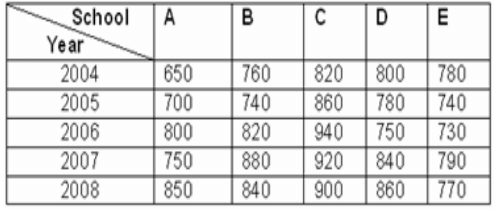
The number of students that appeared from school E in 2004 is approximately what percentage of the total number of students that appeared from all the schools together in that year?
Directions: Study the following information to answer the given question.
Number of students who appeared in SSC examination from five schools over the year
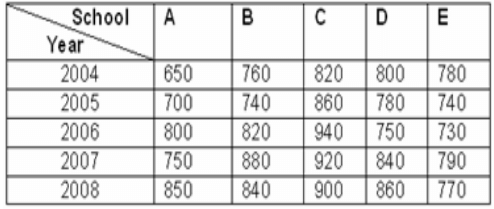
What is the average number of students who appeared for SSC exam from school B for all the years?
Directions: Study the following information to answer the given question.
Number of students who appeared in SSC examination from five schools over the year
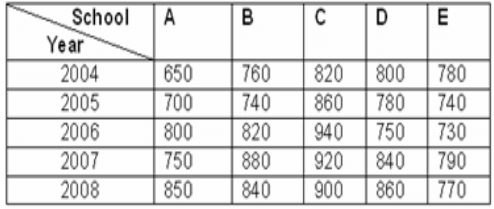
What is the ratio of the total number of students who appeared in 2004 and 2005 together from school C to that of those who appeared from school D?
Directions: Study the following information to answer the given question.
Number of students who appeared in SSC examination from five schools over the year
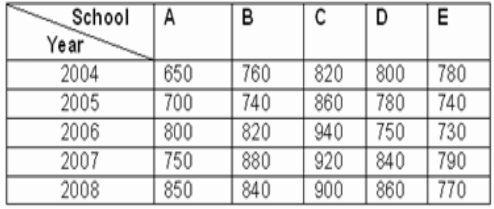
What is the average number of students who appeared from all the schools in 2007?
Directions: Study the following information to answer the given question.
Number of students who appeared in SSC examination from five schools over the year
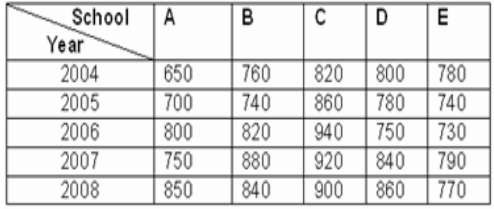
Number of students that appeared in 2006 from school A is what percentage of the total number of students that appeared from school A for all the years together?
Read the following information carefully and answer the following questions
The following table shows the number of branches of different banks in various states
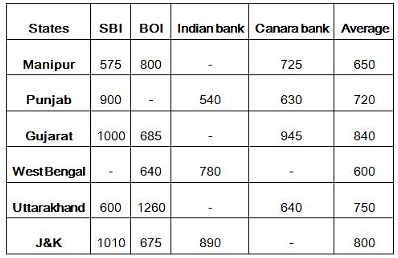
Total branches in the particular states = sum of the branches of all the bank’s branches in that state.
Number of branches of BOI in Punjab is what percentage of number of branches of Indian bank from uttarakhand?
Read the following information carefully and answer the following questions
The following table shows the number of branches of different banks in various states
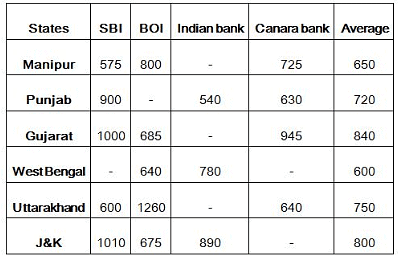
Total branches in the particular states = sum of the branches of all the bank’s branches in that state.
If the number of branches of SBI in West Bengal is 580, then find the difference between no. of branches in SBI and Canara bank from West Bengal.
Read the following information carefully and answer the following questions
The following table shows the number of branches of different banks in various states
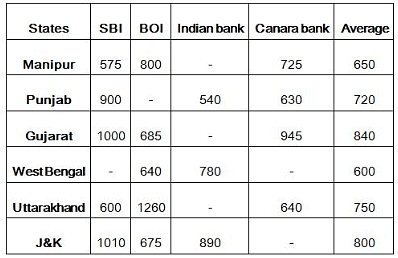
Total branches in the particular states = sum of the branches of all the bank’s branches in that state.
Find the ratio of number of branches in BOI from Punjab to the number of branches in canara bank from J&K.
Read the following information carefully and answer the following questions
The following table shows the number of branches of different banks in various states
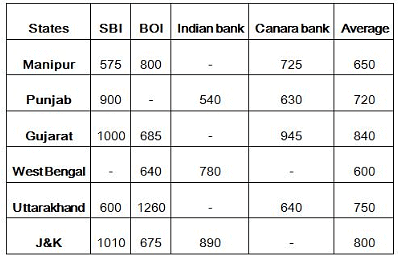
Total branches in the particular states = sum of the branches of all the bank’s branches in that state.
Find the sum of the branches of Indian Bank in all the states together.
Read the following information carefully and answer the following questions
The following table shows the number of branches of different banks in various states
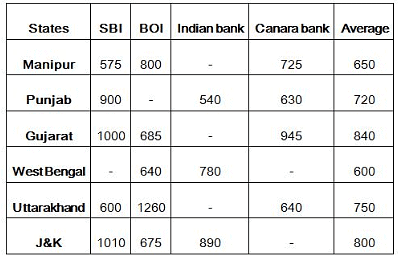
Total branches in the particular states = sum of the branches of all the bank’s branches in that state.
Find the average (approx.) number of branches in BOI from all the states together.



